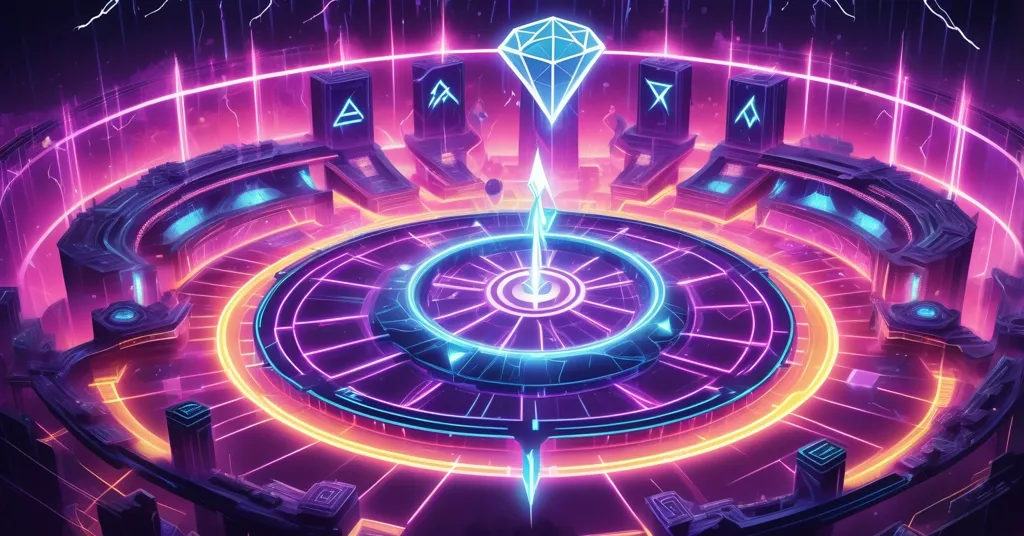BNB Chain vs Ethereum vs Solana: Which Blockchain Dominates in 2025?

BNB Chain, Ethereum, Solana: Which Blockchain Rules in 2025?
By 2025, the blockchain arena is a battleground of innovation, with BNB Chain, Ethereum, and Solana vying for dominance in speed, cost, and usability. As decentralized tech surges into the mainstream—powering everything from DeFi to Web3 gaming—these platforms are wrestling with the infamous blockchain trilemma of scalability, security, and decentralization, each offering a distinct vision for the future of money and tech.
- Performance Edge: BNB Chain and Solana crush it with near-instant transactions and rock-bottom fees, while Ethereum’s Layer-2 solutions lower costs but can’t match raw speed.
- Niche Strengths: Solana owns gaming and microtransactions, BNB Chain wins on affordability for Web3, and Ethereum remains the titan of institutional trust in DeFi.
- Hard Choices: Each chain forces trade-offs, from centralization risks to user experience quirks, shaping who they best serve.
Here at Let’s Talk, Bitcoin, we’re rooted in the ethos of Bitcoin maximalism—championing decentralization, privacy, and financial freedom. Yet, we can’t turn a blind eye to the vital roles these altchains play in accelerating the crypto revolution, filling gaps Bitcoin isn’t meant to address. Let’s cut through the noise and dissect how BNB Chain, Ethereum, and Solana stack up in 2025, weighing their breakthroughs against their baggage with no sugarcoating.
2025: The Year Blockchain Goes Mainstream
The landscape of 2025 is unrecognizable from a decade ago. Blockchain tech has exploded, with DeFi platforms potentially managing trillions in assets and Web3 gaming onboarding millions of casual users. This mass adoption puts brutal pressure on networks to deliver lightning-fast transactions, negligible fees, and intuitive experiences without compromising on security or decentralization. BNB Chain, Ethereum, and Solana stand as titans in this race, each prioritizing different pieces of the puzzle. Before we dive into the nitty-gritty, know this: there’s no perfect solution yet, but the competition is forging a path toward a decentralized future we can all get behind. For a deeper comparison of these platforms, check out this detailed analysis of BNB Chain, Ethereum, and Solana regarding their speed, fees, and usability in 2025.
BNB Chain: Speed King with a Centralization Catch
BNB Chain, spawned from the Binance juggernaut, has carved out a reputation as the go-to for dirt-cheap, high-speed transactions by 2025. Its Proof of Staked Authority (PoSA) system—where a select group of validators stake BNB to keep the network humming—pushes thousands of transactions per second (TPS) at fees often under a cent. Add to that the opBNB scaling layer, a rollup-style solution that offloads transaction bulk, and you’ve got a blockchain tailor-made for Web3 gaming and microtransactions. Picture buying a virtual skin for your game avatar without the transaction fee costing more than the item—that’s BNB Chain’s playground.
The 2024 Fusion update was a major leap, streamlining its architecture by merging legacy components and boosting performance. Its tight integration with Binance’s centralized exchange makes jumping into the ecosystem a breeze for newcomers: sign up, transfer funds, and you’re gaming or swapping tokens in minutes. Compatibility with Ethereum Virtual Machine (EVM) wallets like MetaMask or Trust Wallet means zero learning curve for most users—just plug in and go.
Here’s the kicker, though: BNB Chain’s cozy relationship with Binance is a glaring red flag for decentralization diehards. With a small, often Binance-influenced validator pool, the network feels more like a corporate extension than a true decentralized system. If Binance faces regulatory heat—say, a government crackdown—or key validators get compromised, the ripple effects could tank stability. For users who value affordability over ideology, BNB Chain’s massive user base (thanks to Binance) and low-cost blockchain transactions make it a Web3 heavyweight. But if you bleed Bitcoin values, this centralization stink might be a dealbreaker.
Ethereum: DeFi’s Unshakable Fortress
Ethereum stands tall in 2025 as the undisputed leader in institutional trust and decentralized finance (DeFi). Its total value locked (TVL)—the amount of crypto staked or locked in its protocols—towers over competitors, with billions fueling lending platforms, NFT marketplaces, and stablecoins. Think of Ethereum as the Fort Knox of crypto: where the big fish park their funds without losing sleep. Since its full shift to Proof of Stake (PoS) in 2022, Ethereum has doubled down on security and decentralization, even if it means its base layer isn’t the fastest kid on the block.
The game-changer came with the 2024 Dencun upgrade, introducing “blobs”—a nerdy term for a data storage hack that cuts costs for Layer-2 rollups like Arbitrum, Optimism, and Base. Rollups, for the uninitiated, bundle thousands of transactions into a single proof logged on Ethereum’s mainnet, slashing fees while piggybacking on its bulletproof security. A mainnet transaction that once burned $5 or more during peak times now often costs mere cents on a rollup, though fees still climb when the network’s slammed. By 2025, whispers of further sharding or Layer-2 interoperability could smooth out kinks, but right now, hopping between rollups feels like navigating a maze of bridges and wallets—a real pain for rookies.
Ethereum’s ace is its ecosystem. Most dApps, from Aave to Uniswap, are built to run on it, and its developer community is a buzzing hive of innovation. Ethereum’s DeFi dominance in 2025 is no accident—it’s the backbone of interoperable finance. But honestly, it’s not the slickest option for everyday users. Even with rollups, fees don’t touch Solana or BNB Chain’s basement rates, and the fragmented Layer-2 experience can baffle anyone craving simplicity. Still, for high-stakes projects and corporate adoption, Ethereum’s battle-hardened foundation remains the gold standard.
Solana: Speed Demon with a Learning Curve
Solana roars into 2025 as the undisputed speed champ of Layer-1 blockchains, hell-bent on raw performance. Its hybrid Proof of History (PoH) and Proof of Stake model sidesteps traditional consensus bottlenecks. PoH, in layman’s terms, is a cryptographic clock that timestamps transactions to keep the network in sync without endless node chatter, delivering block times under half a second—basically real-time. Fees are laughably low, often a sliver of a cent, making Solana the darling of consumer dApps, especially for Web3 gaming and high-frequency trading where latency is the enemy.
Early hiccups with congestion and outages—when Solana flopped harder than a meme coin rug pull—are mostly history by 2025. Updates like version 1.18 in 2024 and the hyped Firedancer client have beefed up reliability, with TPS potentially hitting 100,000 if projections hold. Its ecosystem is on fire with gambling apps, trading tools, and games—think playing a blockchain shooter where every kill or loot drop confirms instantly without nickel-and-diming you. Solana’s resurgence as the best blockchain for gaming in 2025 is undeniable.
But there’s a rub: Solana isn’t EVM-compatible, so devs and users must grapple with its Rust-based coding and native wallets like Phantom or Solflare. If you’re hooked on MetaMask’s simplicity, brace for a climb. Skeptics also murmur about decentralization, given Solana’s smaller validator count compared to Ethereum’s sprawling network. Could its speed obsession leave security gaps as adoption spikes? By 2025, rumored EVM bridge efforts might ease onboarding, but for now, Solana’s blistering pace demands you adapt or get left behind.
The Blockchain Trilemma: Pick Your Poison
At the core of this 2025 face-off is the blockchain trilemma: the brutal trade-off between scalability (mass transaction capacity), security (attack resistance), and decentralization (distributed control). BNB Chain prioritizes scalability and speed, but its centralized validator setup is a glaring weak spot. Ethereum bets big on security and decentralization, sacrificing base-layer speed and leaning on rollups for affordability. Solana goes all-in on scalability with lightning transactions, yet questions linger about its long-term decentralization and vulnerability.
No chain nails all three, and that’s the raw truth. Your choice hinges on what you value most. Building a real-time dApp? Solana’s speed is worth the quirks. Running a DeFi empire? Ethereum’s trust and liquidity are unmatched. Launching a budget Web3 game? BNB Chain’s fees won’t bleed you dry, if you can stomach the Binance shadow. This tug-of-war fuels innovation, pushing each network to up its game, even if a perfect balance remains a pipe dream.
Bitcoin’s Lens: The True North of Decentralization
As Bitcoin maximalists, we view this altchain showdown through the prism of Bitcoin’s uncompromising mission: pure decentralization and financial sovereignty. Bitcoin isn’t built for gaming microtransactions or flashy dApps—nor should it be. It’s digital gold, a secure store of value that anchors the crypto space with unmatched resilience. BNB Chain, Ethereum, and Solana experiment in niches Bitcoin sidesteps, accelerating adoption through sheer diversity. We applaud their disruption of centralized systems, aligning with effective accelerationism (e/acc), but we’re not blind to their compromises. Bitcoin sets the bar for freedom; these contenders must prove they’re not just shiny toys diluting the cause.
Playing Devil’s Advocate: Are We Sacrificing the Essentials?
Let’s flip the script and poke some holes. Is Solana’s speed fetish a disaster waiting to happen? A network this fast, with fewer validators than Ethereum, could be a fat target for coordinated attacks as its user base swells in 2025. Is Ethereum’s rollup labyrinth a roadblock to mainstream adoption? If swapping between Layer-2s feels like decoding a crypto cipher, your average Joe will bounce. And can we trust BNB Chain’s performance when it’s shackled to Binance’s regulatory baggage? One wrong move—a global ban or hack—and the house of cards wobbles. These aren’t comfy thoughts, but if we’re serious about a decentralized tomorrow, we can’t dodge the hard questions.
Key Questions and Takeaways
- What makes BNB Chain a standout for low-cost blockchain transactions?
Its opBNB scaling layer and PoSA consensus drive thousands of TPS at fees under a cent, perfect for Web3 gaming and microtransactions, with seamless Binance integration as a bonus. - How does Ethereum hold DeFi dominance in 2025 despite pricier fees?
Ethereum’s massive TVL, ironclad security, and sprawling developer ecosystem cement it as the trusted hub for institutional DeFi, with Layer-2 rollups cutting costs since the Dencun upgrade. - Why is Solana the top blockchain for gaming in 2025?
With block times under half a second and fees near zero on Layer 1, Solana nails real-time, low-cost transactions vital for gaming and high-frequency trading dApps. - What are the key trade-offs of picking Solana over Ethereum or BNB Chain?
Solana’s non-EVM setup forces users into Rust programming and native wallets like Phantom, a tougher slog than the familiar EVM environments of its competitors. - Does BNB Chain’s centralization taint its blockchain cred?
Absolutely—its small, Binance-linked validator pool screams central control, a no-go for decentralization purists despite its speed and affordability perks. - Will any blockchain conquer the trilemma of scalability, security, and decentralization by 2025?
Don’t hold your breath. BNB Chain chases speed, Ethereum guards security, Solana pushes scalability—each sacrifices something, proving the trilemma’s still a beast to tame.
The 2025 clash of BNB Chain, Ethereum, and Solana underscores a powerful truth: diversity in blockchain design is turbocharging the revolution. Each platform, flaws and all, challenges centralized finance and propels us toward a freer financial system. At Let’s Talk, Bitcoin, we salute this relentless experimentation, even when it veers from Bitcoin’s purist path. Whether it’s Solana’s breakneck speed, Ethereum’s unyielding trust, or BNB Chain’s wallet-friendly hustle, the crypto space thrives on this fight. So, which blockchain claims your allegiance? And more crucially, will 2025 birth a trilemma-solver, or are we just revving up for the long haul? Keep watching—the stakes couldn’t be higher.



